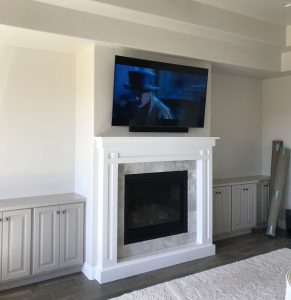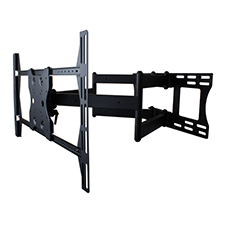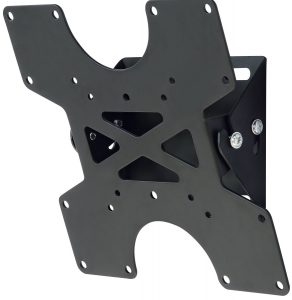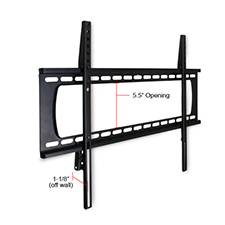The TEK-IT Way for Custom TV Wall Mounting
Moving into a new home is a chaotic nightmare. There are so many tasks to complete and we want everything to be perfect in our new home.
Installing new electronics brings much-needed comfort, relaxation, and entertainment. It should be at the top of the list for new homeowners. WIFI and network, audio systems, security and surveillance systems, and wall-mounted TVs should be among the first considerations.
Benefits of a Wall Mounted TV
- Wall-mounted TVs look better
- No pesky cords dangling from the back
- Kids can’t slime the TV or pull it down on themselves
- TV takes up less room
- More furniture arrangement options
- And on and on
However, a wall-mounted TV is no easy task and can sometimes be costly!
Should you DIY your TV mount?

These days almost all retail stores that sell TVs also offer TV mounting brackets. With this and access to DIY videos on YouTube, you may be considering hanging your TV. After all, it is just a few screws in the wall and ta-da, right?
At TEK-IT we take TV wall mounting seriously. A TV is one of the
main focal points in a room and the one place where all of your systems come together as a visual display. It needs to be perfect, and achieving perfection, even with all the right tools and products, is no easy task.
This is why we highly recommend having your television installed professionally.
Whether you have your TV installed professionally or decide to tackle the beast yourself, you’ll need to keep in mind these key tips from the pros.
Use good quality products
TV mounting brackets. Should be pretty simple, right?
You have a 65” TV and you buy a box that says it’s for a 65” display. Piece of cake?
When you shop for brackets you’ll realize, there’s no cake. Even at a retail store that offers many options, finding the right bracket for your installation is difficult. We have even found that some retail stores offer nothing but lousy brackets!
We have used a myriad of different TV mount bracket brands and find that you get what you pay for! We recommend that you don’t go for the cheapest option because the end result will be affected.
| Protip: All good quality mounting brackets have “post-level adjustments” which is a way for you to hang the TV, then fine-tune it with ease and precision after it’s already on the wall. This is extremely important because sometimes we find that a TV needs to be tilted one way or another to parallel the lines above or below the TV. i.e. a mantle, the ceiling, trim, or a cabinet.
Sometimes we will even hang a TV slightly crooked because it looks right that way. This can only be achieved with a post-level adjusting bracket. Using a bracket without post-level adjusting will quickly prove to be, whatever the price, seriously not worth the money. |
Use the correct products for the job

Now that you’ve got a good-quality bracket in mind, which one are you going with?
Your options are articulating, tilting, or fixed brackets.
All of these brackets have different uses and nothing looks worse than a TV mounted with the wrong bracket.
Articulating Brackets:
These are probably the most commonly misused brackets by far. They are also the most expensive and the most difficult to install!
Uses for an articulating bracket:
- The TV must be angled off the wall toward the viewing area
- TV must be mounted in a corner
- TV mounting area is recessed,
- Wiring behind the TV is impossible to reach unless the TV can be pulled away from its resting position
Other than these reasons there is no need to install an articulating bracket. Cost of the bracket aside, it is just too difficult for the average person to achieve a clean result with an articulating bracket.
We see messy articulating bracket installs all the time, even by some “pros” and believe me it’s an eyesore. That having been said, sometimes articulating brackets are just what the doctor ordered, and thank goodness they exist!

Tilting brackets:
Tilting brackets are probably the most commonly used.
Tilting brackets with post-level adjusting are easy to get right and look fantastic on a wall. These nestle up close to the wall but still allow the installer to point the TV down toward the viewer to eliminate glare.
The tilt bracket is the easiest to install and has a great end result.

Fixed brackets:
This is by far the best-looking result when done properly.
The fixed bracket allows the television to sit very close to the wall which gives that amazing clean look as if it were a picture frame and typically no cords or brackets are visible, even from a side view.
The biggest problem is what to do with the power, cable, data outlets, and any other connection cabling that is necessary for your specific installation. These clean, low-profile installations require much more prep work and often require the use of wall boxes and other equipment typically not available to the average consumer at retail locations.
Position outlets in the right place
I argue that THE most important step to a clean wall-mounted TV is where the power, video, and data outlets are placed. These minor but critical details can be a real pain in the neck if not considered beforehand and positioned appropriately.
On an articulating mount setup, you need to be aware of how the bracket will open, close, and swing in relation to your outlets on the wall and what that motion will do to cords plugged into the TV.
For the tilting bracket just position them above the bracket and you’ll be golden. Just make sure that you don’t go so high as to allow them to be exposed above the TV – the closer to the bracket the better.
On a fixed mount, you need to make sure that no plugs are restricted in the little amount of space between the TV and the wall. This sort of thing does require a load of experience, but if you think about the result and how it will all work together you should be able to come up with a good solution. The key is to think ahead and make proper measurements.
If you have decided to go for a DIY custom TV mount installation, these considerations should aid in achieving a brilliant result. If you want to hire a professional to complete the installation, they should accept nothing less than a perfect-looking wall-mounted display. Choose a professional that considers everything.
